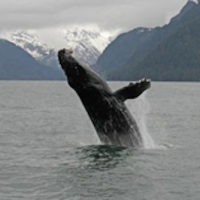Conservationists Question Marine Fisheries’ Delisting of Certain Humpback Whales
 Humpback whale (photo: Getty Images)
Humpback whale (photo: Getty Images)
By Ramona Young-Grindle, Courthouse News Service
WASHINGTON (CN) - Conservationists are concerned about the delisting of nine populations of humpback whales while the number of whale entanglements in fishing nets is on the rise. The National Marine Fisheries Service finalized its delisting of nine distinct population segments of humpback whales Thursday. Four other populations will remain listed as endangered, and one population was downlisted to threatened status.
The entire species of humpback whales had been listed as endangered under the Endangered Species Act since 1970. The move to divide the species into population segments and to delist some of them was spurred by a 2013 petition from the Hawaii Fishermen's Alliance for Conservation and Tradition to reclassify and delist the North Pacific humpback population, and a 2014 petition from the state of Alaska to reclassify the Central North Pacific population and remove it from ESA protection.
The original proposal would have delisted ten populations, kept two populations as endangered, and downlisted two populations to threatened status.
"Today's news is a true ecological success story," Eileen Sobeck, assistant administrator for the fisheries service, said. "Whales, including the humpback, serve an important role in our marine environment. Separately managing humpback whale populations that are largely independent of each other allows us to tailor conservation approaches for each population."
The Arabian Sea population, the Cape Verde Islands/Northwest Africa population, the Western North Pacific and Central America populations will continue to be protected as endangered species. The Mexico population, which feeds off the coasts of California, Oregon and Alaska, has been downlisted to threatened status. Endangered Species Act protections for the West Australia, East Australia, West Indies, Hawaii, Brazil, Gabon/Southwest Africa, Southeast Africa/Madagascar, Oceania and Southeastern Pacific humpback populations have been removed.
"Some humpbacks are on the road to recovery, thanks to the tremendous power of the Endangered Species Act, but the job isn't finished. These whales face several significant and growing threats, including entanglement in fishing gear, so ending protections now is a step in the wrong direction," Kristen Monsell, an attorney with the Center for Biological Diversity conservation group said. "At the very least, the feds must address the huge increase in whales getting tangled up in fishing gear along the West Coast."
The group claims that nearly 40 reports of whale entanglements off the west coast for the first half of the year signals that the 60 entanglements reported last year by the agency will be superseded, marking a dangerous climb in these reports over the past three years.
In addition, the group questions whether the agency has reached its own recovery plan goals for the whales. "The whales' recovery plan set the goal of reaching 60 percent of the historical carrying capacity for the North Atlantic and North Pacific populations, but it is not possible to assess whether this criterion has been met because of information gaps, including a lack of reliable estimates of deaths due to entanglements," the group maintained.
The Whale and Dolphin Conservancy also voiced concerns in reaction to the delisting news. Noting that, according to the agency's own data, a subset of the Western North Atlantic population of fewer than 1000 whales that feeds in the Gulf of Maine is being significantly impacted by entanglements and ship strikes, the group feels the delisting is premature for some populations.
"Just this year, at least 12 humpbacks have been found dead along the U.S. East Coast and that number does not include the more than a dozen humpback whales that have been reported as entangled there" Regina Asmutis-Silvia, the WDC's North American executive director, said. "Further, their growth rate has not met goals in their recovery plan. For the NMFS to imply that these whales have somehow met recovery is tragically misleading at best and makes a mockery of the Endangered Species Act."
The NMFS maintains that protections for the whales continue under the Marine Mammal Protection Act and the 1982 whaling moratorium by the International Whaling Commission, which remains in effect.
The WDC terms this an "empty reassurance," because the protections are not the same as those under the ESA. "The threshold for determining unsustainable human-caused impacts to these populations will rise considerably once the species is removed from the endangered species list. Additionally, the delisting will eliminate the requirement that agencies and foreign governments consult with NMFS and provide an assessment of the likely adverse impacts of their activities before allowing potentially harmful activities," the group noted.
In separate regulations filed concurrently with the delisting rule, the agency has specified distance limits for vessels approaching whales in waters off Hawaii and Alaska in a further effort to offer some protections for the whales.
The delisting rule and the two approach rules are effective Oct. 11.
To Learn More:
Record Number of Whales Snared in Fishing Gear off West Coast (by Ken Broder, AllGov California
Navy Asks Permission to Harass Whales (by Noel Brinkerhoff, AllGov)
- Top Stories
- Unusual News
- Where is the Money Going?
- Controversies
- U.S. and the World
- Appointments and Resignations
- Latest News
- Musk and Trump Fire Members of Congress
- Trump Calls for Violent Street Demonstrations Against Himself
- Trump Changes Name of Republican Party
- The 2024 Election By the Numbers
- Bashar al-Assad—The Fall of a Rabid AntiSemite






Comments